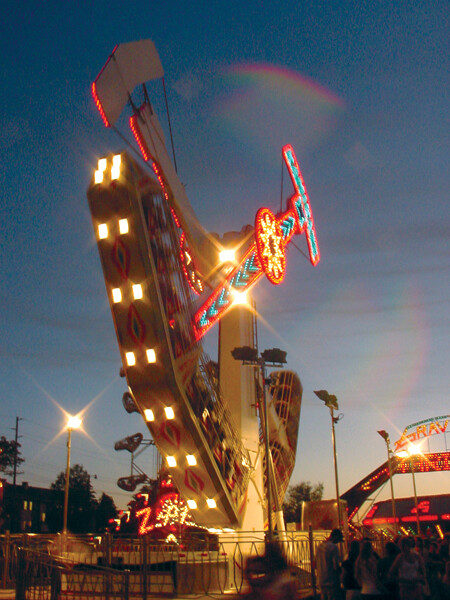Historic Spotlight: The Gallatin County Fairgrounds
Courtney Kramer | Wednesday Jul. 1st, 2015

The Gallatin County Fairgrounds, located 10 blocks north of Main Street, are the northern boundary of the street grid that characterizes Bozeman’s historic core area. The Fairgrounds are an accessible connection to Montana’s agricultural economy and have provided community gathering space since 1903. The highlight of the year is the Gallatin County Fair, which will be held July 13-19, 2015.
County fairs originated in the early 19th century as an annual tradition among farmers and ranchers in the United States and the British Empire. They provided an opportunity for far-flung farm families to socialize, show and sell livestock, trade farming techniques to improve crop yields and show off crafts and domestic arts. Horse trading and selling at fairs naturally evolved into horse racing, a sport which dominated the public’s interest in the 19th and early 20th centuries. Competitions between cowboys to saddle break wild horses in the American West lead to the incorporation of rodeos at fairs. Carnivals, and the ubiquitous Ferris wheel, became a fair staple.
Helena hosted the first Montana Territorial Fair 1869. By the 1870’s, newspapers around the state provided readers detailed reports on the exhibitions, which reflected the territory’s evolving economy. In 1874, the Helena weekly Herald reported that the exhibitions included, “examples of mineral ore mined in Montana,” as well as “agricultural, stock, home manufacture and ladies’ departments.” The same article reported extensively on the horse races, which began with a trotting race of mile heats. The best three in five races won a purse of $150, with $50 to the second place finisher. Of the seventeen paragraphs describing the 1874 Territorial Fair, twelve reported on horse racing activities.
Fair grounds were developed in Butte and Missoula during the 1870’s and in Anaconda in the late 1880’s. Newspaper articles of the era provide insight into other ways communities used fairgrounds. Cricket matches, baseball games and Army encampments used the open spaces of the fairgrounds as a public meeting space. Fourth of July fireworks displays were held at the fairgrounds around the state, as well as displays of new innovations like hot air balloons parachutists who jumped from the hot air balloons.
But the horse races dominated the public’s imagination, to the extent that developers of fairgrounds prioritized the construction of a race track over other improvements. The Great Falls Tribune speculated on the suitability of the Montana’s plains for a racetrack in 1886, by writing, “One of these days some of the broad, level acres about here will be laid out for a fairground and race-track, for Montanians are proverbially fond of contesting the honors of the turf with horses of noble blood.” Five years later, the North Montana Fair Association spent $10,000 to develop a racetrack at the Great Falls fairgrounds.
Despite agriculture’s domination of the Gallatin Valley’s economy, a fairgrounds was not developed in Bozeman until 1903. “The Interstate Fair association today let the contract for the fencing of the fairgrounds near this city,” reported the Butte Inter-Miner newspaper. “The tract contains 80 acres. There will be a new grandstand erected which will have a seating capacity of 1,000 people. The track will be one of the fastest in the Northwest and an effort will be made to locate the state fairs here instead of at Helena. The expenses are being borne by the local sportsmen.”
The fairgrounds, which occupied 27 city blocks in the Imes Addition, was owned at the time by Syracuse University, of New York. For reasons that remain unclear, Syracuse University offered the high bid of $16,682 to acquire the property from the trustee of Louis Menage’s bankrupt estate in September 1895. Menage’s company, Northwestern Guaranty Loan, speculated in real estate developments between Minneapolis and Seattle in the 1880’s and early 1890’s. Through his Bozeman attorney William Imes, Menage annexed and subdivided the West Park, Westside and Capital Hill Additions to Bozeman in 1890, in anticipation of a real estate boom in the event that statewide voters selected Bozeman as the state’s capital. Bozeman finished fourth in the election and Menage’s Capitol Hill Addition is now home to Montana State University, which Bozeman received as a third runner up prize in the election.
The financial panic of 1893 caused an economic depression, and Northwestern Guaranty Loan collapsed under the weight of its speculative investments. Menage fled his creditors, initially to Canada and later to South America. Despite reports of his murder in Honduras in 1895, Menage returned to Minneapolis in June 1899 to face charges of stealing nearly $700,000 from his company before fleeing. In the meantime, the Gallatin District Court ordered Menage’s Bozeman’s real estate holdings sold by the Gallatin County Sherriff at Auction, with the proceeds used by the trustee to satisfy Northwestern Guaranty Loan’s creditors.
Syracuse University partnered with the Inter-State Fair Association, an organization lead by Bozeman notables like Nelson Story, F. L. Benepe, Julius Lehrkind and Walter Sales, which sold sells shares in the organization to raise funds to develop the property.
Improvements on the fairgrounds are recorded on the 1904 Sanborn Fire Insurance Map of the area. A mile-long racetrack skewed from northwest to south east, with a one-story exhibition hall tucked under a two story grand stand situated to the southwest of the track. The grand stand faced north east towards the judge’s stand and racetrack beyond, ensuring spectators a seat in the shade during fair events. A handful of cattle, hog and sheep pens are outlined to the west of the grandstand and an eight foot high fence enclosed the fairgrounds. The entrance, at the end of North Black Avenue on Tamarack Street, included a gate and ticket box.
In 1912, a “Women’s Pavilion” was added to the southeast of the grandstand and a set of bleachers to the north before 1912. The organization’s balance sheet recorded $8,762 in profits in 1912.
Perhaps under a previous agreement, Gallatin County purchased the Inter-state fairgrounds from Syracuse University in 1914 for $9,000. The Fair Board continued to invest in the property by adding bleachers and exhibit buildings through the early 1940’s. World War II severely curtailed fair activities, but by the late 1940’s livestock shows at the fairgrounds brought Gallatin Valley ranchers back to the fairgrounds.
In 1949 the Fair board approached the City of Bozeman to diversify uses of the Fair Grounds property by building a sports field for football and baseball on the site. “Their proposed plan,” noted the City Commission minutes, “would make it possible to eliminate the present City Ball Park and the High School football field on north Grand Avenue. The estimate of cost of work proposed to be done this fall would be $1,500.00 or less.” The City Commissioners supported the idea and eventually authorized the City crews to install 438 feet of water pipe to help irrigate the ball field.
Sometimes uses at the fairgrounds caused problems between agencies. In November 1950, the Gallatin County Airport Board asked the “City Commission to consider levying of a tax to be turned over to the Gallatin County Airport Board and to be used exclusively for the maintenance of the landing strip recently constructed at the Gallatin County Fairgrounds… many people use the landing strip to come to Bozeman and make purchases in the City.” Unfortunately, the airplane strip is not indicated on the 1957 Sanborn Map of the fairgrounds. The map does, however, indicate the construction of new exhibit buildings and the removal of the racetrack.
As the Gallatin County Fair, and associated carnival and rodeo grew, community use of the property expanded. City Commission minutes from the 1950’s, 1960’s and 1970’s reveal frequent requests for permits to hold events at the Fairgrounds, from teenage dances hosted by the Jaycees to benefit Immunization Drives and 4th of July Fireworks displays. A number of parades used the fairgrounds as a beginning or ending point, including those for the College National Finals Rodeo in the 1980’s.
Today, the Gallatin Valley Fairgrounds is a unique departure from Bozeman’s street grid. The Fairgrounds continue to provide community event and recreation space. The Gallatin Valley Fair continues to give community members an opportunity to socialize, introduce children to the farm animals they read about in books and go on carnival rides in the twilight of a Montana summer evening.
| Tweet |
